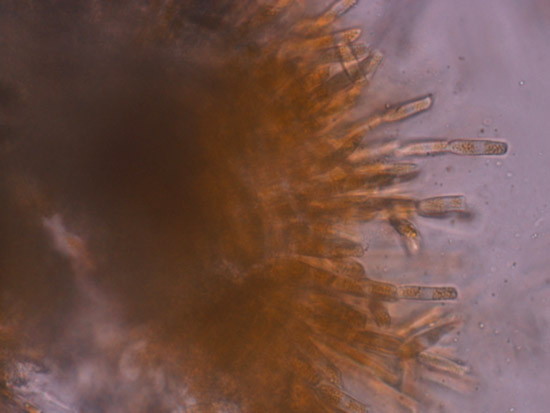Issue 3, May 7, 2012
Spruce Needle Rust
The plant clinic has received a couple of Spruce samples that were found to be infected with Spruce Needle Rust (Chrysomyxa spp.). Several species of fungi belonging to the genus Chrysomyxa are known to cause rust on spruce. Most Chrysomyxa species are heteroecious and require more than one host to complete their life cycles. Weir's spruce cushion rust (Chrysinyxa weirii) is unique in that it is autoecious and does not require separate hosts to complete its life cycle. Control strategies differ between the herteroecious and autoecious species. As a result, laboratory analysis of infected needles is critical for accurate diagnosis and subsequent control strategies.
Chrysomyxa weirii. Weir's spruce cushion rust infection occurs in the spring, as new needles are emerging. Symptoms of the disease, however, are not seen until the following spring when the 1-2 year old needles develop yellow spots. As the infection progresses, the spots develop pustules that split open to reveal yellow-orange teliospores (first image, below). In some cases, a heavily infected tree can have an abundance of pustules and teliospores, which results in a yellow-orange appearance to the tree when viewed from a distance. Diseased needles may drop, with repeated defoliations resulting in reduced growth. The pathogen is spread as the teliospores produce basidospores, which are then blown or splashed onto newly emerging needles of the same tree or nearby spruce trees. New infections occur and the disease cycle then repeats in the same fashion.

Yellow-orange teliospores protruding from a pustule on a spruce needle. The spores form a distinctive tongue or ribbon-like mass.

Magnified view of teliospore chains. Individual teliospores were approximately 7 x 27 μm
Control. Damages caused by Spruce needle rusts are mostly aesthetic and should not affect the long-term health of the tree. General control recommendations are to purchase healthy disease free trees and to maintain plant vigor. Chlorothalonil is a fungicide labeled in Illinois to control Weir's spruce cushion rust (Chrysinyxa weirii). Spray applications should begin once 10% of the tree's buds have opened. Repeat applications should be performed at 7-10 day intervals until the needles have matured. (Travis Cleveland)
Author:
Travis Cleveland